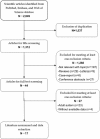Prenatal, perinatal, and postnatal factors associated with autism: A meta-analysis
- PMID: 28471964
- PMCID: PMC5419910
- DOI: 10.1097/MD.0000000000006696
Prenatal, perinatal, and postnatal factors associated with autism: A meta-analysis
Abstract
Background: The aim of this meta-analysis was to investigate the prenatal, perinatal, and postnatal risk factors for children autism.
Methods: PubMed, Embase, Web of Science were used to search for studies that examined the prenatal, perinatal, and postnatal risk factors for children autism. A fixed-effects model or random-effects model was used to pool the overall effect estimates.
Results: Data from 37,634 autistic children and 12,081,416 nonautistic children enrolled in 17 studies were collated. During the prenatal period, the factors associated with autism risk were maternal and paternal age≥35 years, mother's and father's race: White and Asian, gestational hypertension, gestational diabetes, maternal and paternal education college graduate+, threatened abortion, and antepartum hemorrhage. During perinatal period, the factors associated with autism risk were caesarian delivery, gestational age≤36 weeks, parity≥4, spontaneous labor, induced labor, no labor, breech presentation, preeclampsia, and fetal distress. During the postnatal period, the factors associated with autism risk were low birth weight, postpartum hemorrhage, male gender, and brain anomaly. Parity≥4 and female were associated with a decreased risk of autism. In addition, exposure to cigarette smoking, urinary infection, mother's and father's race: Black and Hispanic, mother's country of birth outside Europe and North America, umbilical cord around neck, premature membrane rupture, 5-minutes Apgar score<7, and respiratory infection were not associated with increased risk of autism.
Conclusion: The present meta-analysis confirmed the relation between some prenatal, perinatal, and postnatal factors with autism. All these factors were examined individually, thus it was still unclear that whether these factors are causal or play a secondary role in the development of autism. Further studies are needed to verify our findings, and investigate the effects of multiple factors on autism, rather than the single factor.
Conflict of interest statement
The authors have no conflicts of interest to disclose.
Figures
References
-
- Association AP. Diagnostic and Statistical Manual of Mental Disorders, Fourth Edition. Washington, DC. American Psychiatric Association 1994.
-
- Bertrand J, Mars A, Boyle C, et al. Prevalence of autism in a United States population: the Brick Township, New Jersey, investigation. Pediatrics 2001;108:1155–61. - PubMed
Publication types
MeSH terms
LinkOut - more resources
Full Text Sources
Other Literature Sources


